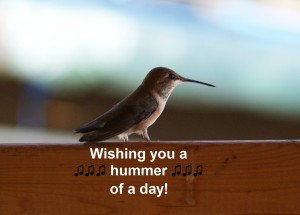
Even the non bird nerd will stop and marvel at the antics of a hummingbird. So tiny, so agile and so quick! I truly applaud those that can get photos of these flying gems; most of my attempts are nothing but a blur. Hummingbirds are my all time favourites and I could just sit and watch them for hours on end.
The hummingbirds in our area usually arrive around mid April. The usual species you will see at your feeders are Rufous, Calliope and Black-chinned.
I’ve been seeing a lot on the Internet about hummingbird diseases from Facebook friends and was reminded how important it is to keep the feeders clean. One particular friend has found 4 dead hummingbirds, not because his own feeders weren’t fastidiously clean but more likely because someone his neighbourhood has dirty feeders. Passing along this information to your friends & neighbours will insure your hummingbirds live a long, healthy life. Remember we are only supplementing their diet with our feeders and their stomachs are as delicate as the birds themselves.
Sanitizing the feeders is very important and once a week is a good rule of thumb especially if you see black mould. Soak your feeder in a bleach solution (1 tsp. of bleach to 1 qt. of water) for about 15 minutes. Rinse thoroughly and air dry to let any bleach residue dissipate. Do not use soap or detergent to clean your feeders as the residues from these could harm the hummingbirds. Always place your feeders in a sheltered location out of direct sunlight as this will spoil the solution faster and will cause the black mould and certain death for the hummingbirds.
Replacing the nectar every 3 to 5 days is a good practice and is especially important in the hot summer months.
The typical nectar solution is one part sugar to 4 parts water (‘never’ honey or other sugar substitutes which are both very harmful to hummingbirds), boil, cool and serve. The solution can be kept in your refrigerator for at least a week. There is no need to add red food colouring to the mixture as it may also affect the birds. Not enough is known about the effects of the dye and it is better to be safe than sorry. Hummingbird diseases include Aspergillosis, Salmonellosis and Mycobacteriosis. Candidiasis (Thrush) also affects the hummingbirds and is most likely the problem if you see the birds sitting for long periods at your feeders with their mouths open and extended tongue. If you do see this, death may be imminent. The more hummingbirds you have, the higher chance of spreading infection. Keeping your feeders clean is the only way to prevent these deaths.
In the wild, a hummingbird’s diet is mostly the nectar of flowers and small insects. Placing a piece of fruit near your feeders can add extra excitement as the birds swoop in to grab the insects the fruit attracts. Providing water for hummingbirds will add to your viewing pleasure. Unlike the rest of our feathered friends, hummingbirds rarely use a typical birdbath. They get their water from the nectar of flowers and our feeders. They do like to bath though and I’ve had many fly through the spray from my hose nozzle as I’ve watered the gardens. Misters are a wonderful way to provide water. If positioned to spray nearby leaves, the hummingbirds will be attracted to the sound and the wet leaves which acts as a bath when they rub on them. If the mist is not too strong you may be lucky enough to see them fly back and forth through it or hover in place. Very shallow birdbaths are also perfect for hummingbirds. Old dinner plates work well as does adding rocks to a deeper birdbath in order to create shallow pockets. Having perches near the bath also adds to your viewing pleasure as you watch them primp and preen after they’ve had a good scrub. The most important message of all is ensure your feeders are clean and you will be able to enjoy the hummingbirds for years to come!
Until next time, happy birding and happy humming!
A voice for the northern bird


